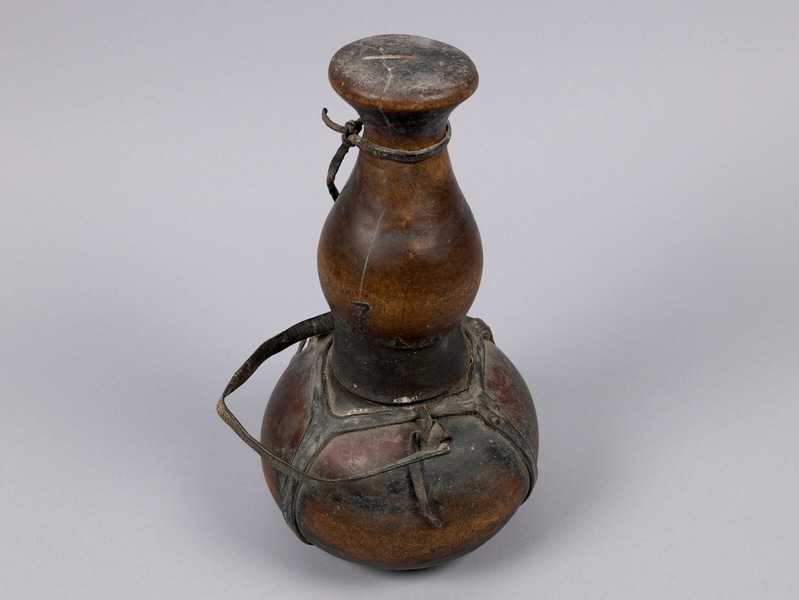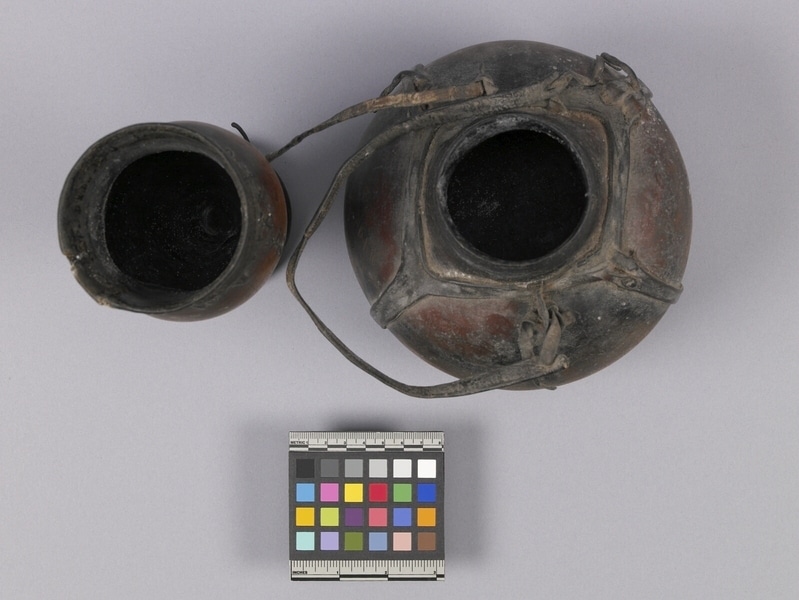Container Item Number: Aj110 from the MOA: University of British Columbia



Description
Round pot-like-shaped container: lower half is round and short with a leather strap going over the mouth forming four straps connecting on the bottom and knotted together. Larger in the centre then narrowing at the top. Leather around the neck connecting to the leather on the lower half. Once painted red, blood, and ochre, worn off in most areas.
History Of Use
Milk containers, determined by their long necks, are made by women for men to use on long journeys; referred to as angrum, akurum or apangkech. The rounded bottoms of the containers make them more stable in sand, and the lids function as cups. Transport containers are distinguished by their projections and straps, which can be hung over the shoulder or lashed to animals; some are made to look like calabashes. Fresh milk is called nalapan and can be fermented within gourd containers. Once fermented, the milk can be combined with cow urine and water, and shaken, to create butterfat (akidetet) and buttermilk (ngakibok). Butterfat can then be converted into ghee (akimet) and protein/mineral sediment with heat. When heat is applied to buttermilk it creates dried curds (edodo) and whey. This act of converting fresh milk products into other dairy products allows Turkana pastoralists to keep food reserves during months of low milk yield and periods of drought.
Milk and other dairy products are extremely important to Turkana pastoralists, and cattle are the living embodiment of wealth. Even with urbanization, wealth being associated with owning cattle is prominent. Cattle are often exchanged through economy activity and social practices; for example, they are often exchanged as a marriage rite.
Cultural Context
storage
Specific Techniques
The wood used is likely from the species delonix elata, called ekuruchanait by the Turkana people. The skin composing the straps would have been harvested through the process of akiyeng, meaning "to skin with a knife". The skin was likely bound to the wood with the use of a thick needle used in leather working, called an emutu or ngimutun. These skills are mostly known to women since they are the principal creators of containers. The staining and paint on the container has mostly faded but would have included ochre and blood.
Item History
- Made in Kenya before 1978
- Collected during 1978
- Owned by Marta Friesen before March 3, 1981
- Received from Marta Friesen (Seller) and Museum of Anthropology Shop Volunteers (Funding source) on March 3, 1981
What
- Name
- Container
- Identification Number
- Aj110
- Type of Item
- container
- Material
- leather skin, wood and ochre pigment
- Manufacturing Technique
- carved, tied, cut and cured
- Overall
- height 33.5 cm, diameter 17.7 cm
Who
- Culture
- Turkana
- Previous Owner
- Marta Friesen
- Received from
- Marta Friesen (Seller) and Museum of Anthropology Shop Volunteers (Funding source)
Where
- Holding Institution
- MOA: University of British Columbia
- Made in
- Kenya
When
- Creation Date
- before 1978
- Collection Date
- during 1978
- Ownership Date
- before March 3, 1981
- Acquisition Date
- on March 3, 1981
Other
- Condition
- fair
- Accession Number
- 0705/0001